When the double action, swing-out cylinder revolver began to take shape in the late 1800s, it seemed like the designers had already used up all their energy by the time they got to the back end. The grip frames on these guns were universally small, and the grips (or “stocks,” in S&W parlance) almost looked like they were afterthoughts.
The tiny handles of wood or hard rubber used by Colt’s and Smith & Wesson on these early “Hand Ejectors” left a large part of the upper frame and recoil shoulder area completely exposed. They closely followed the lines of the skinny frames, giving nothing extra to hang onto. It was Peter Paul Mauser’s legendary autopistol that earned the sobriquet of “broomhandle” in this era for its unusual grip, but the Hand Ejectors didn’t lag far behind in terms of poor ergonomics.
Fixing the grip
These skinny grip frames didn’t give much purchase to control the gun during recoil, and they also didn’t work very well for shooters with normal-to-large sized hands, who quickly ran out of space to put all their digits. A better solution was obviously needed.
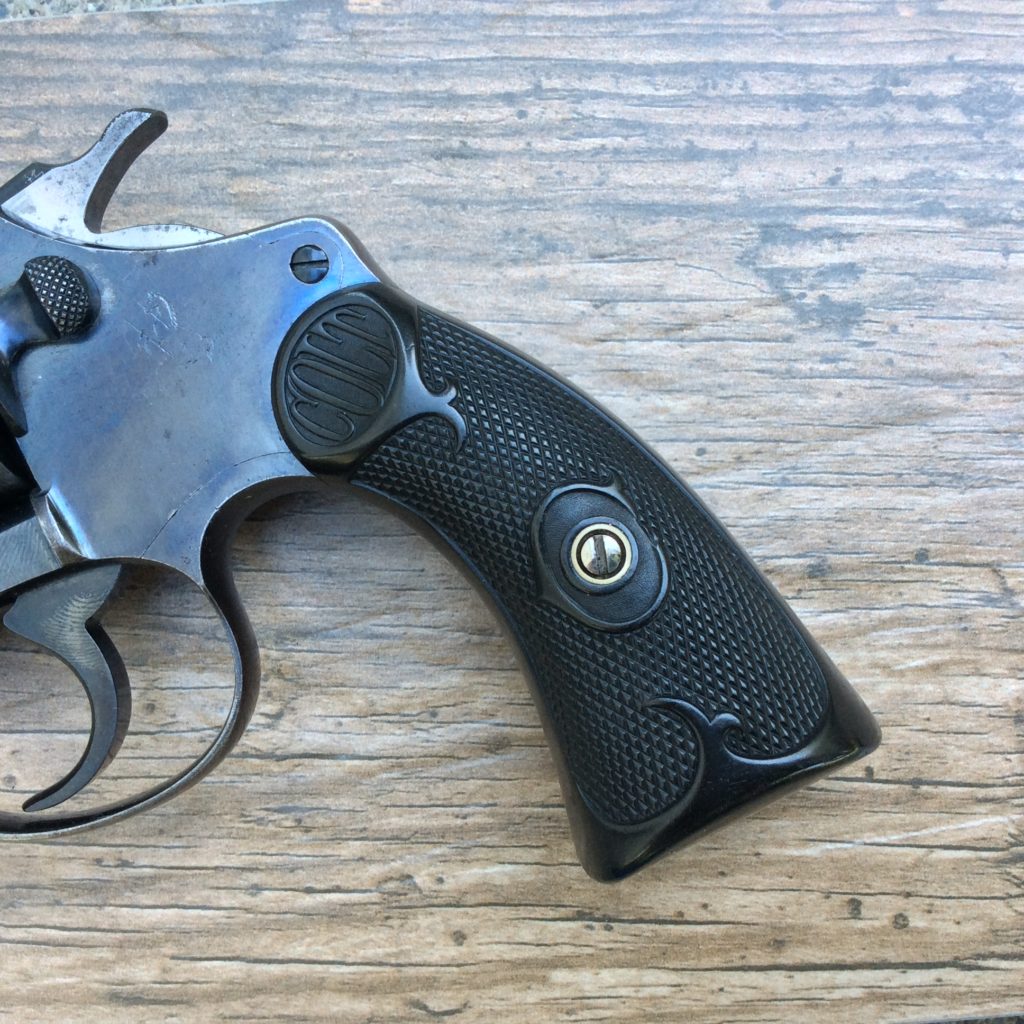
The fix came in the form of grip adapters, which were added to the skinny frames to change the shape of the gripping surface, and reposition the hand on the frame. These adapters were used in conjunction with the existing stocks to change the feel of the gun, and the idea was popular enough that they were made by many companies.
Smith & Wesson introduced their first grip adapter for the N-Frame guns around 1932, with a K-Frame version that followed around 1934. The Smith & Wesson grip adapter had two blued steel plates which fit under the stock panels, and held a rubber filler in place (which was secured to the plates by a screw) in the area forward of the front strap and behind the trigger guard. This adapter filled the area where the frame rests on the middle finger, in a similar manner to the Roper-style target stocks that were starting to become popular in this era.
Other companies, like Pachmayr, Mershon and Tyler produced their own versions of grip adapters in the post-WWII era with great success. These designs were different than the S&W adapter, because they were composed of a single, curved piece, instead of several parts. These adapters did the same job, however, and filled the gap behind the trigger guard.
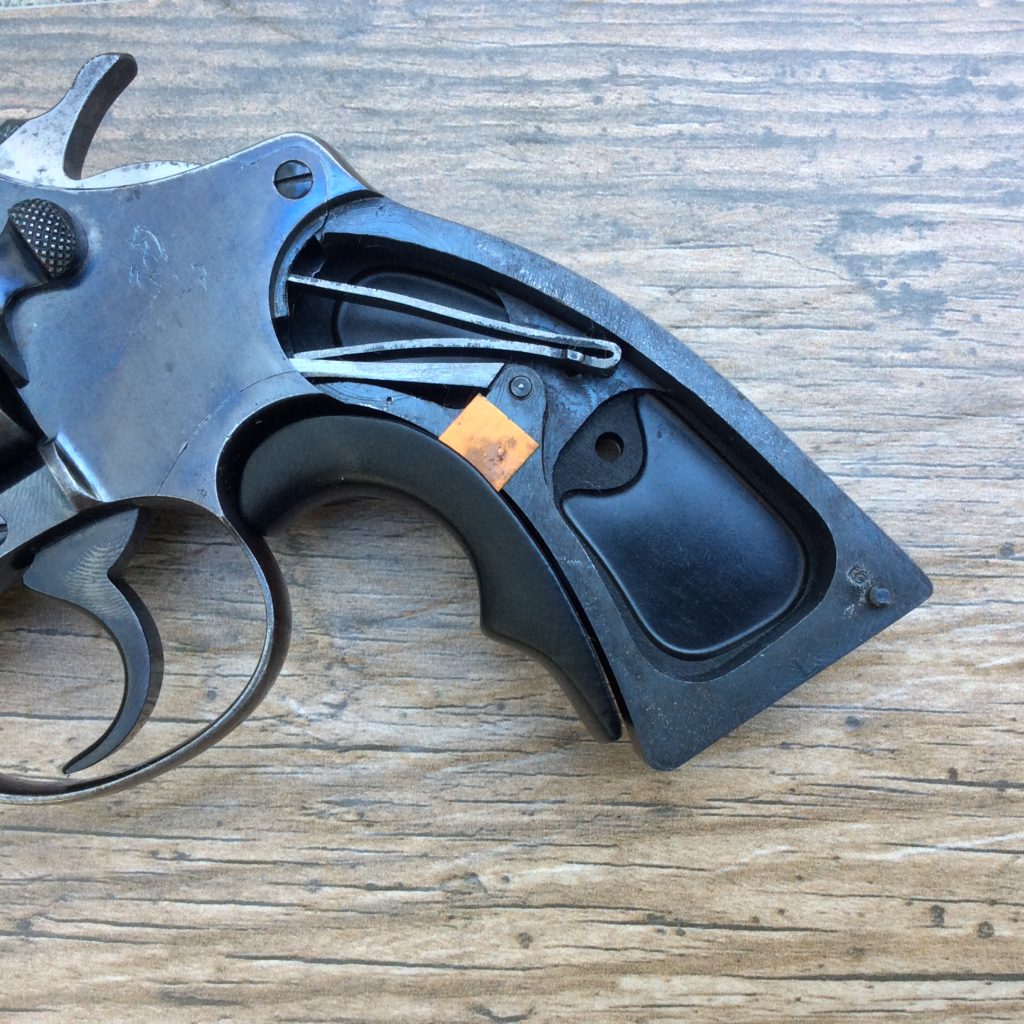
The single-piece adapters had little metal tabs that extended on the backside of the adapter. These metal tabs gripped the front strap of the frame, and the grip/stock panels were placed over them and secured in place with the grip screw, which held the adapter in place.
Smith & Wesson developed their own copy of this design in the 1950s, and the collection of companies did a good business selling the adapters even after the improved (but still not great) S&W Magna-style stocks were introduced right before WWII.
Survivors
The influence of Walter Roper’s target stock design was strong, and it wasn’t long before Colt’s and Smith & Wesson were making their own target-style handles, circa 1950s. The target stocks made grip adapters unnecessary, and as they became more popular in the 60s and 70s, the market for grip adapters began to fall off. By the time disco was being replaced by new wave, only the Tyler T-Grip remained in production.
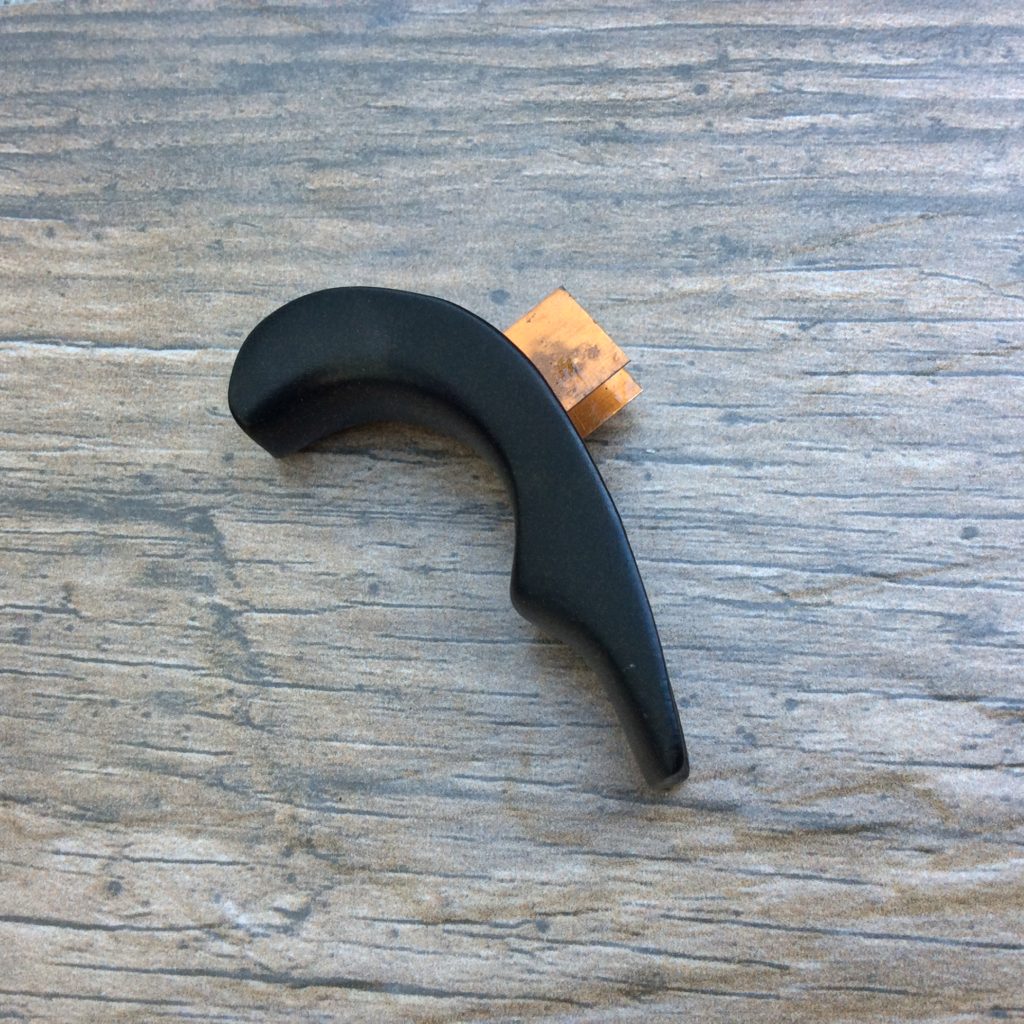
Today, we’ve still got Tyler Manufacturing making grip adapters (after some interruptions, as the family business changed hands) and they’re joined by a new kid on the block, BK Grips. The Tyler units are made from either aluminum or bronze, and the BK Grips units are made from molded polymer, but they all perform the same function.
Changes
The grip adapters fill the area underneath the frame and behind the trigger guard, where the gun rests on your middle finger. As a result, your grasp on the gun is shifted downwards on the frame.
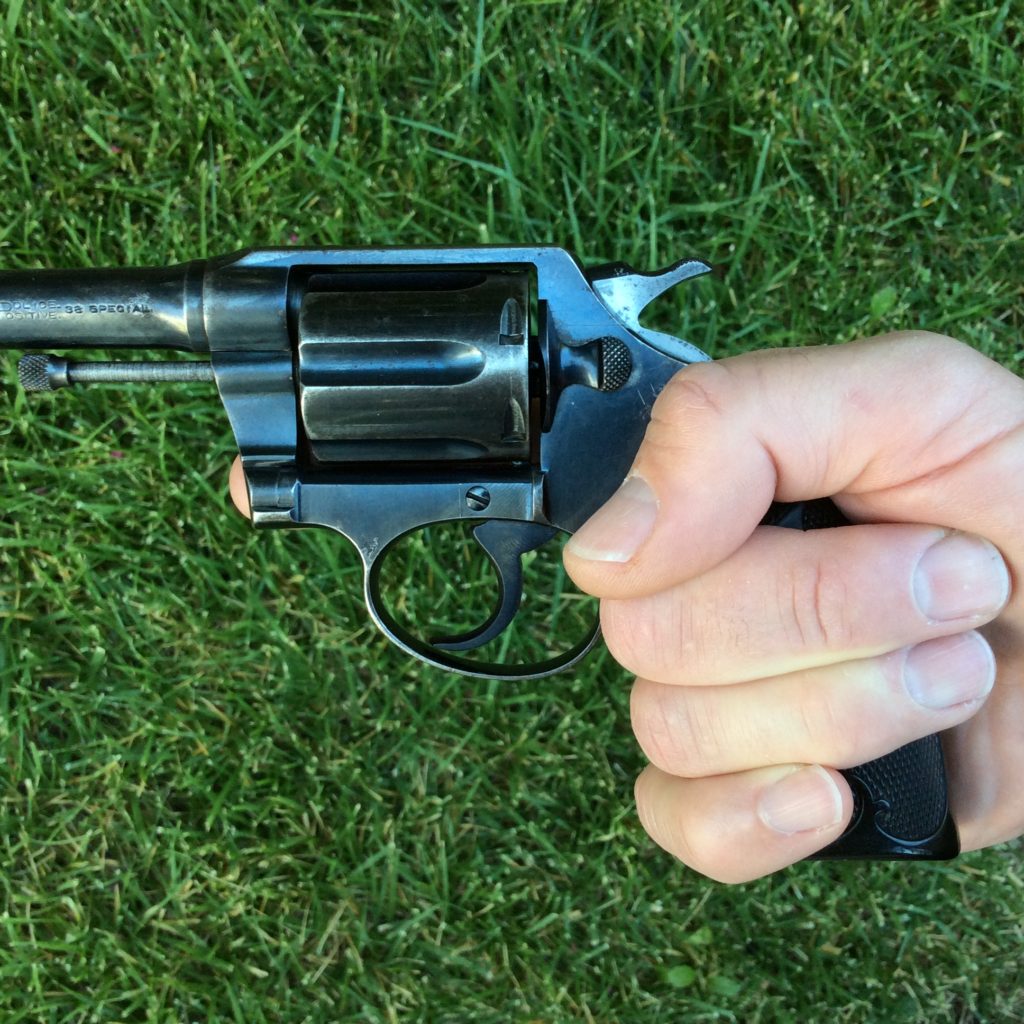
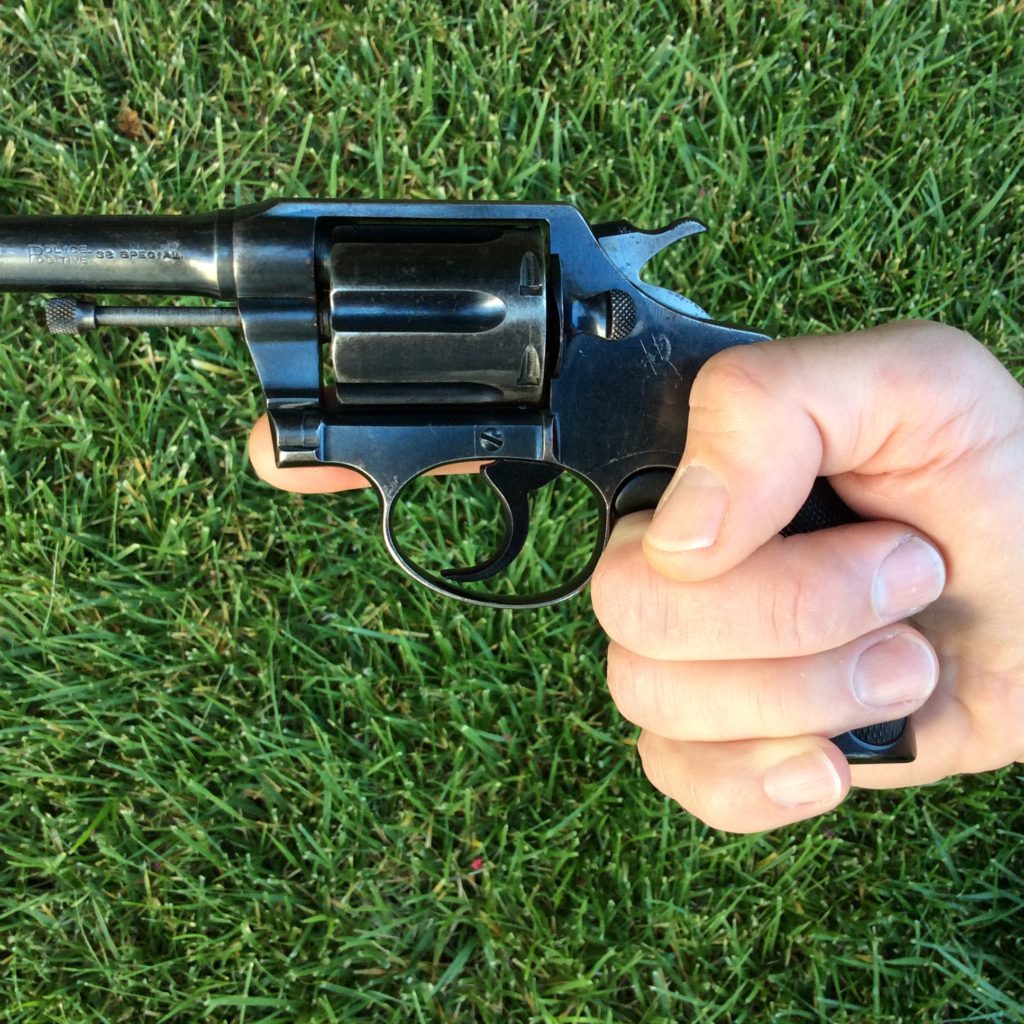
This was the design intent of the target stocks popularized by Roper in the 1930s. It was felt that forcing the hand lower on the frame would place the trigger finger in a better position to work the trigger straight to the rear. The in-line relationship between the trigger and finger would give better control and accuracy, particularly in the single-action fire that was popular at the time in the target shooting games.
I think the adapters accomplish this well, but with a big hand like mine, things can feel a little crowded behind the trigger guard, particularly with the smaller D-Frame Colts and J-Frame Smith & Wessons. Additionally, you can run out of grip frame really quick, and the bottom of your hand can be hanging off the bottom edge of the gun with nothing to hold onto.
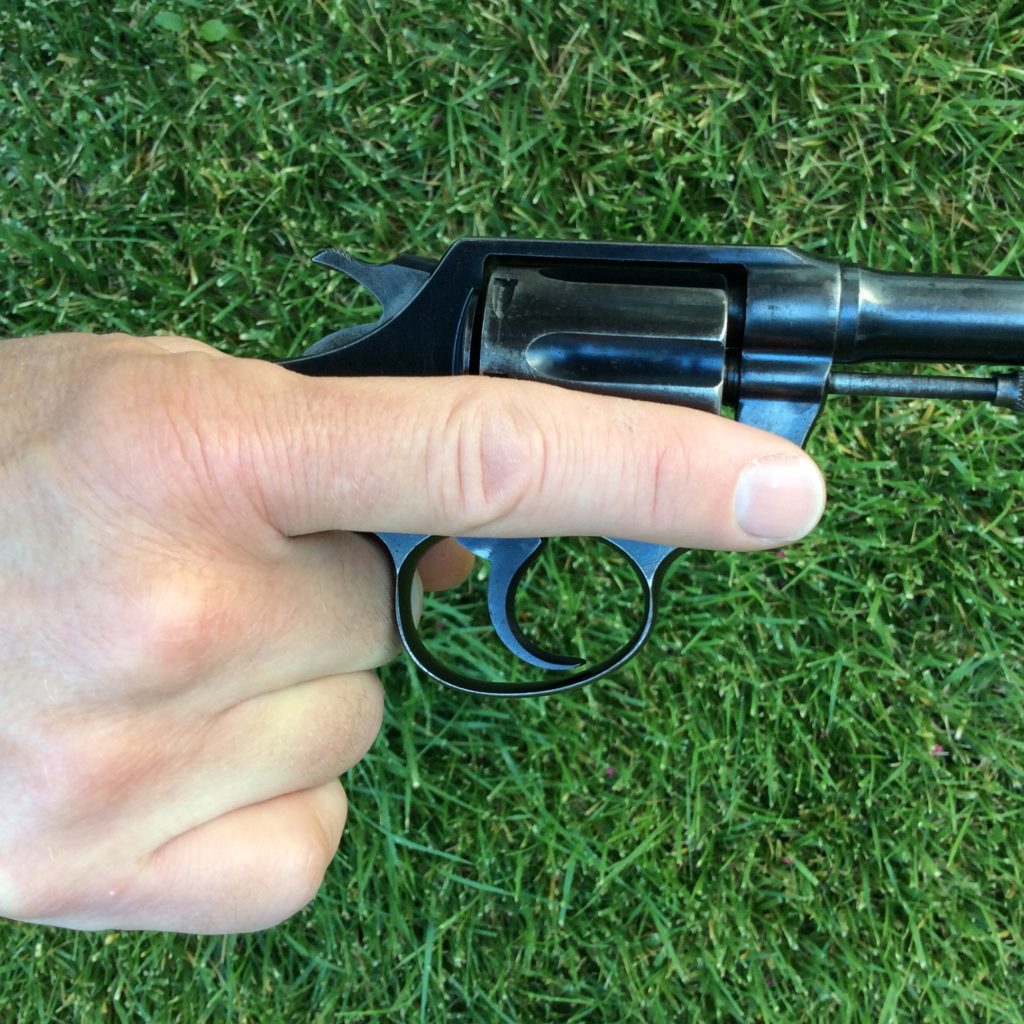
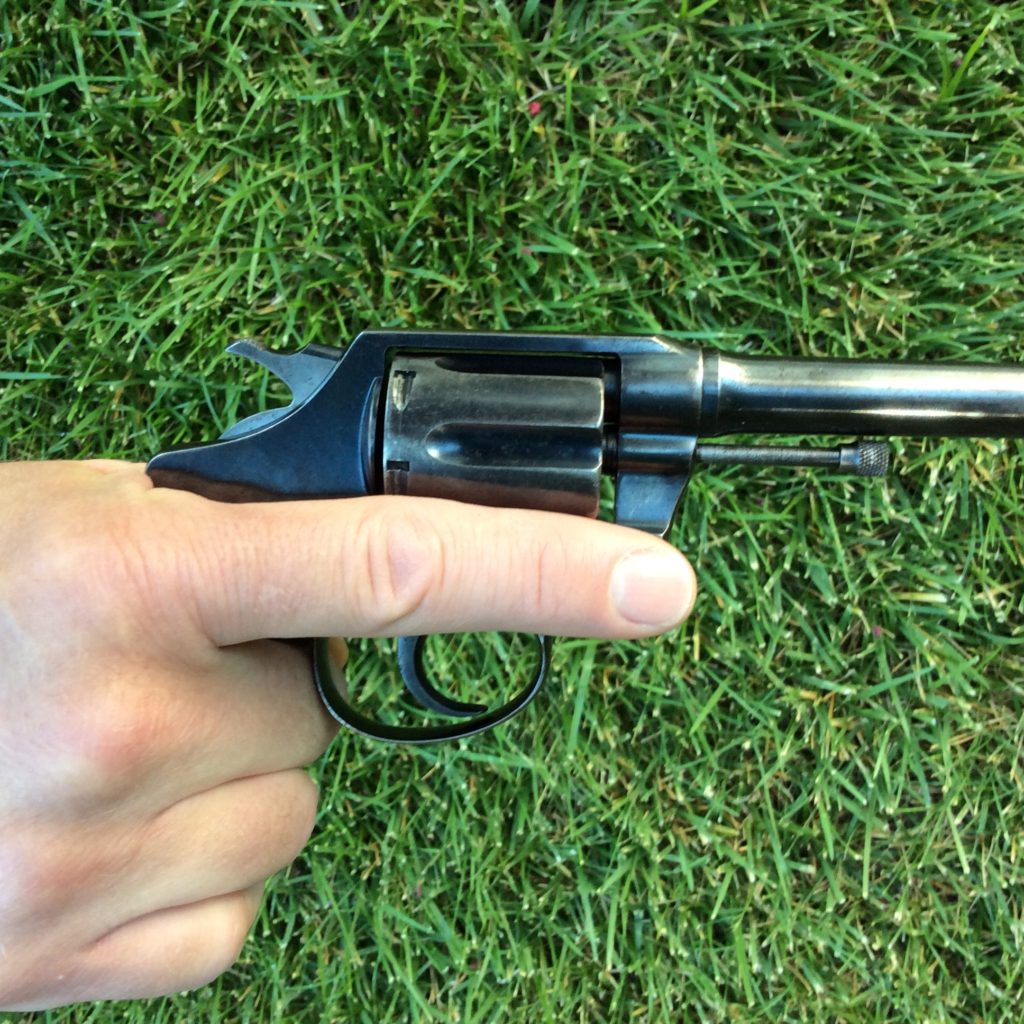
As a result, I like the adapters better on the medium-frame guns (like the Smith & Wesson K-Frames) where they fill my hand better, without pushing fingers off the bottom of the gun, or making it feel crowded by the trigger guard.
The old Pachmayr units lacked finger grooves, but both the Tyler and BK Grips products incorporate a single finger groove on the front, to aid in control. This is one of those things that you’ll either love or hate, depending on how the adapter fits your hand. I personally find that the finger groove sometimes hits me in the wrong spot, and would prefer an adapter without one, but there are none in production without the groove, currently. If you search around on the internet, you can still find some old Pachmayr units without the finger groove, if you really want them.
Obsolete?
From a practical standpoint, I think I’d rather have a good set of stocks on my gun than try to augment a poorly-designed set with a grip adapter. The adapters help to fill the hand a little more, but there’s a lot more material in a good set of stocks, and I find that I get a more comfortable and efficient fit with them.
However, every hand is unique, and for a lot of RevolverGuys out there, a grip adapter is the perfect solution. One benefit I have to concede is that the grip adapters allow better access for a speedloader than the vast majority of replacement stocks out there. If you stick with the “splinter grips,” and augment the frame with an adapter, your speedloader isn’t going to have to fight its way into the cylinder like it does with many stock designs. Score one for the grip adapter.
Plus, there’s something about a grip adapter that makes it look “right” on an older gun. You could put a modern set of stocks on an old Colt, but they would look out of place. It’s kinda like putting oversized rims on the family sedan—you could do it, but it just wouldn’t look right. Life’s too short to shoot an ugly or goofy looking revolver, so that’s not an inconsiderable benefit of the grip adapter.
The grip adapter seems like it still has legs, and I’m glad. It’s a neat way to carry on the RevolverGuy tradition!

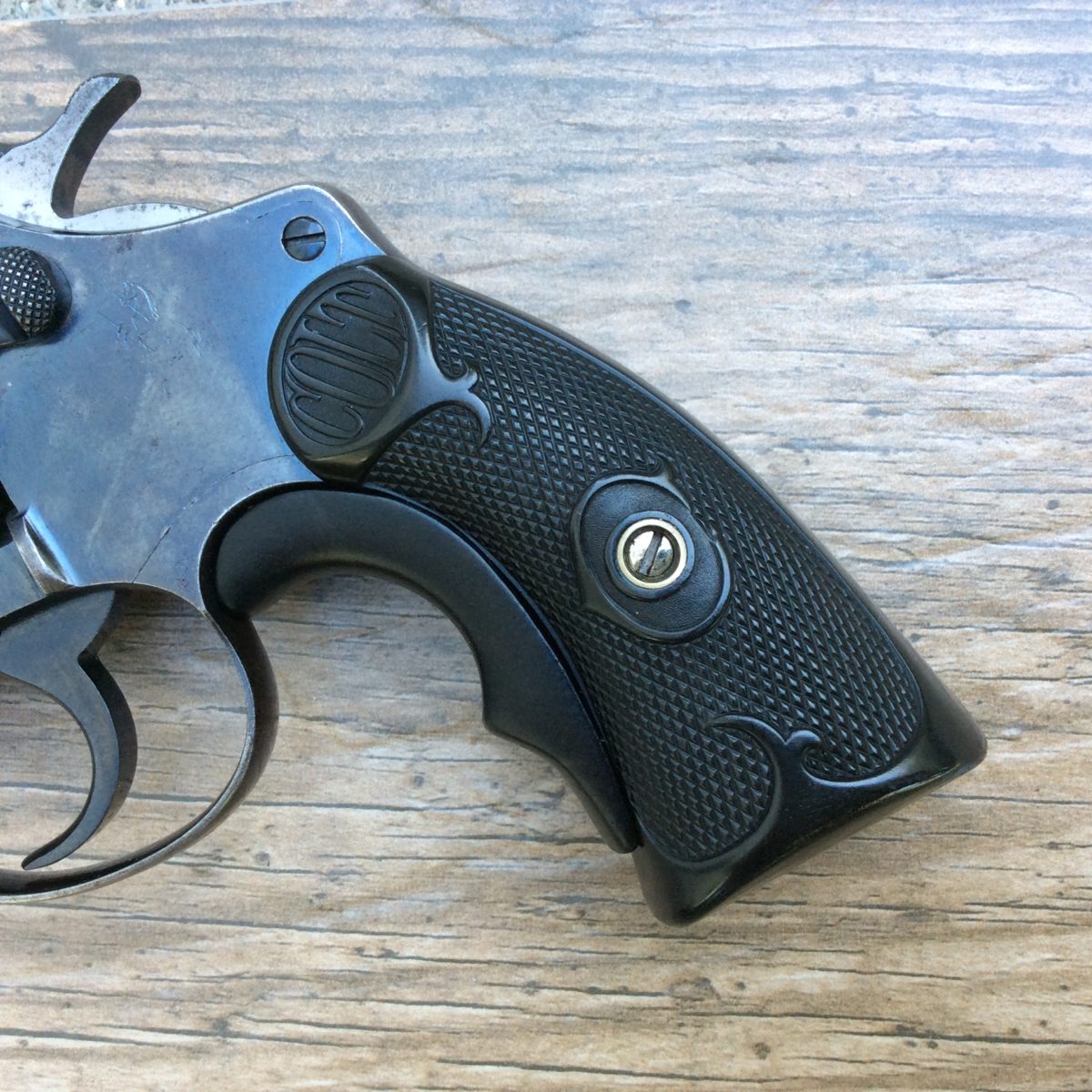
In the late 1970s Shooting Times gun writer
Skeeter Skelton proposed his “dream revolver.”
The back of the frame came down farther almost
to the back of the trigger guard. But the proposed
“dream revolver” still had what looked like
magna stocks ala S&W.
Interesting article, Mike, and it addresses a concern of mine.
I’ve recently found myself in need of pocket-carry once/week when I visit a friend in a rough neighborhood. My daily life otherwise does not lend itself to CCW (it’s open carry on the farm or no guns at my place of employment). Anyhow, my finalists for a pocket revolver are a vintage S&W 649 .38 (stainless, no lock), an SP101 snub DAO hammer, or a Kimber K6S. All are heavy guns but that’s what works for me currently with a Taurus 85 with Crimson Trace Grips. I dress for the gun and cover the hammer with my thumb, practicing a lot drawing it.
I amazes me how much grips/stocks can change a handgun’s character. We had Hogue Monogrips on the Taurus for years (these vintage 85s are actually good shooters) and the CT did not change things much. My ideal now are small grips that do not compromise shooting .38 +p hollowpoints from a heavy snubbie (probably the Critical Defense Lites we keep in the 85, not +p, from a SS 649). Both the Ruger and Kimber come well equipped stock and fit my hand and pocket well, but if I find a vintage S&W at the next gun show with dinky stock grips, I’m going to be coming back here for advice.
Glad you found it helpful!
You’re right–the 85 is a solid gun, and probably the best Taurus ever. I’m a little leery of the 90 grain Critical Defense load and would actually prefer to run 148 grain wadcutters instead, for a light load. If recoil is the concern, they’re a great choice. They’ll penetrate better and will cut a bigger hole, without battering your hand.
I like the grips that came on the K6s and think the stock Ruger grips are pretty decent, too. Your 649 could really benefit from an adapter, or a set of boot grips, for your CCW pocket carry mission.
I will give the wad cutters a try. The 85 does not deliver great follow-up shots when firing the full Critical Defense +p rounds.
I can definitely see that. The hotter loads can be a handful in these guns. I’ll be interested to hear what you think of the WCs.
I would agree with the wadcutters, but you might also consider the Critical Defense standard pressure 110gr load. The 110gr FTX bullet used in the standard pressure and +P loads actually performs better at standard pressure velocities, and works a little better for reloads due to the pointed bullet. I have actually carried with wadcutters in my gun and the Critical Defense standard pressure loads in my speed loaders. I would kind of like the heavier weight of Federal’s Nyclad 125gr for the reloads, but I don’t think that round is available anymore.
Hot +P flyweight loads in .38 revolvers versus a 148-158 grain flat face profile (WC/SWC) – especially snub guns – at least to me, is like asking which is going to do more damage to you inside your new Ford F-150, or Chevy Silverado,
(a) a rice-rocket doing 100 mph, or
(b) a Kenworth tractor pulling a 64,000 pound load going 35 mph
In a snub gun, nothing says “I love you” quite like throwing a 158 LSWC-HP out the muzzle ( especially the softer alloyed Winchester version )
Decisions, decisions.
Uh-oh! You’re probably not going to enjoy next week’s post…
I’m going to do a 10 foot, 158 gr shoot-off soon with wadcutters, Hornady std. pressure XTP, and some Buffalo Bore short-barrel, standard pressure .38s with the LSWC-HC bullet. Want to see how recoil, point shot from pocket draw, and follow-ups work for another in center-of-mass and “one in the hat.”
Will be entertaining and, I hope, educational. The Taurus will soon fall back to a home-defense backup, but I want the best round possible in that little and very dependable snub. My next pocket carry is going to be +p capable without much recoil, and both the SP and K6S seem to fit that bill well.
Don’t forget the 148 grain WCs. Good, low recoil option. Great penetration. I have more faith in them than some of the light JHPs.
While this is way off topic, the only .38 +P hollow points I shoot anymore are Federal HST 130gr. I haven’t found anything else that has the same highly consistent penetration and expansion in a .38 load, which I think is something you really have to pay attention to if you’re choosing to carry a .38. Too many options in this cartridge offer pretty inconsistent performance from what I’ve seen, which is a large part of the reason I’ve moved away from carrying a .38.
The majority of .38 Special loads aren’t tailored for the snubs, and you wind up having a bullet that dances on the lower margin of the velocity envelope where you’ll get reliable expansion from a JHP. The shorter tubes just can’t push the bullet into the heart of that envelope with reliability.
The other issue is that there isn’t a lot of surplus energy to play with. A bullet that expands probably won’t go very deep, because it runs out of steam so fast. Some calibers can expand well and still penetrate deeply, but the .38 Special is not one of them, and if it was, you wouldn’t want to shoot it in a snubby anyhow.
Load selection is definitely more important in this caliber than others, and sometimes you have to make some hard choices. If penetration is your priority, you’ll probably need to favor the heavier projectiles, unless you’re willing to put up with extremely high pressures (and attendant recoil). They won’t expand much, but they’ll go the distance.
Newer loads like the 135 gr. Gold Dot SB and the 130 gr. HST were designed to fix this problem with the more traditional offerings. They seem to do a good job of splitting the middle ground and are a solid choice, I think. Probably the best JHP choices out there. Unfortunately, the HST’s profile makes it a bad choice as a reload.
My carry load in a steel frame snub is the .38 Buffalo Bore 110 gr Barnes all copper HP. Its rated at 1100 fps out of a 2″ barrel. From what I have seen and read this is one load that reliably expands and penetrates at least 12″ out of a snub, even through clothing. In my S&W 638, any +P load is too much–I would just carry wadcutters in that gun–no expansion but they do cut a full caliber wound channel and definitely penetrate enough.
Best,
Paul
Indeed, Mike. Particularly when it comes to the .38 snub, you can’t just grab any random hollow point load off the shelf at the store and assume it’s going to do what it’s supposed to. Make deliberate, informed choices regarding the loads you stake your life on (and that’s by no means limited to the .38 cartridge).
Btw, Lucky Gunner just added the .38 HST load to its extensive ballistic testing list:
https://www.youtube.com/watch?v=kXxbVP1mwGk
Grip adaptors have their place and they really shine when you need to improve the grip without enlarging the overall profile of the gun. However with the advent of Craig Spegel’s “Boot” grips (and all of the copies) they have largely been replaced. There are situations where the original grips plus a grip adaptor is still the perfect solution.
Another niche where a grip adaptor may be useful is the Werner Carry System. When used as part of the Werner Carry System a Tyler Grip adaptor is combined with Barami Hip-Grip and a Hogue Handle Jr. Sleeve. Seen here: https://snubtraining.wordpress.com/2009/07/13/snub-training-werner-carry-system/
It’s an interesting setup, but reminds me of Jim Higginbotham’s dictum that “we all must find our own salvation.” I personally don’t like the hooked grip option (Barami, DeSantis, Rogers all make a version, and I’m probably missing others) because I think it sacrifices security, allows the weapon to shift around (sacrificing consistency in the drawstroke), and makes it harder to establish a good firing grip. With a good holster, I can achieve a similar level of concealment, without those negatives.
Still, it might be the ideal system for someone else with different circumstances or preferences.
The boot grips are my preferred solution for low profile, as RG readers have seen in the photographs that have accompanied my articles. That doesn’t mean they’re better than splinter grips with an adapter, it just means they work better for me. I’m glad we still have companies making adapters, so everyone has a choice.
I don’t use the Werner Carry System but it’s another tool in the toolbox if I did need it.
I do use Tyler grip adaptors on a couple of revolvers and have always considered them to be a good option for some applications.
I prefer service stocks with the Tyler T-grip on my carry revolvers because that is how I was taught by instructors at Quantico back in the day. Tyler still makes their T-grip to fit the pre-1940 Colt frames, which is just the thing in case you inherited Grandpa’s Banker Special or Grandma’s Pocket Positive. Yes, I have both and while they are not primary carry pieces they work fine for garden varmints around the farm.
The Pre-1940 Colt version is what you see illustrated in this article.
Glad you’re still getting good mileage out of yours! They work!
Big fan of Tyler T-Grips. Put some on the Model 66 issue gun BITD, got the attention of the lieutenant (an administrative type, not much of a street cop). ‘What are you trying to be, some kind of gunslinger?’ ‘Nossir, just want a better chance of hitting what I shoot at.’ He didn’t like them, but didn’t make me take them off. On the plus side, when I found a better set of grips than what came on the gun, found out the T-Grip also fit the Ruger Security Six just as well, and vastly improved those tiny little slivers of wood they used.
Also like the Pachmayer (sp?) Presentation grips; just right on the Security Six and Speed Six for my stubby little digits.
My favorite original-equipment grips are the old GP100 rubber’n’wood design.
Then there are the older Crimson Trace models; don’t care for the laser, but do like the design of the grips.
On thing about it, with all the different models, makes, styles out there, it’s like going to a buffet—everybody gets to choose what they want. Ace
I’m with ya, Ace. Those rubber and wood GP grips are the best factory originals I’ve ever wrapped my mitts around. When they first came out, I didn’t care for the looks, but after several decades of manufacturers putting nothing but black rubber on their guns, I think they’re downright handsome. They still feel great in the hand.
I’m in the market for a grip adapter for a rock island m206. Does anyone know where I can get one or someone that can make one for me. Thanks in advance
Sorry, not aware of anyone making an adapter for that make and model. You might try modifying one for a Colt, to see if that works? Might be easier to just buy some other grips from RIA.
I have both Mershon and Tyler T-Grips on a couple of my revolvers. They work great and allow me to keep the factory style stocks with their factory medallions and good looks. On other revolvers, you’re right Mike, factory target or custom Roper style handles are fantastic.
I totally agree, one has to find the solution for his hand and his tastes. I find I really like a Tyler T-grip with factory stocks (or custom slim stocks), not that I would pass up a deal on a set of Ropers!
I’ll resist the considerable urge to get into the bullet selection thread on this one.
My favorite revolver has a set of nice Sambar Stage thin stocks with a Tyler T-grip, it is a 5-screw 1955 Target 5″. But nothing feels better than a 3″ K-frame round butt with Magnas and a T-grip.
But as they say; “Your Mileage May Vary” 🙂
Well, I’m glad you shared your thoughts re: ammunition in the SuperVel post, Jim! We weren’t going to let you out of here without getting something out of you on that subject. ; ^ )
A Tyler T-Grip is pretty much mandatory on my S&W 12-2, as it’s an earlier one made with the “slightly thinner than regular K-Frame” grip frame; they didn’t standardize it with the rest of the K’s until later. Thus, you’re stuck with the default wood magna grips, since none of the aftermarket K-Frame grips will fit.
I just installed a BK grip adapter on my model 19 wearing Altamont’s version of a S&W splinter stock. Looks very retro and is a big improvement. In fact, on a K frame square butt like a model 19 with the BK my hand naturally assumes the high-hold position and works well with the wide target trigger. The hammer just kisses the web of my hand when it comes back and I can actuate the trigger with only the last joint of my finger moving. This dramatically reduces the wobbling that goes on through the trigger stroke. Despite that wide trigger this may prove to be good in double action for me. Thanks for the tip-off on BK adapters!
Excellent! Glad you gave them a try, and I really appreciate the valuable feedback on them! It’s good to hear that the BK adapter worked so well for you!